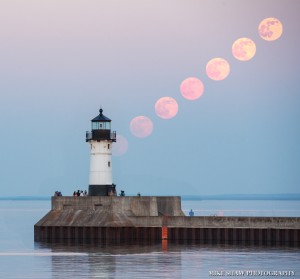
The full moon occurs only once every month, as we all know. But did you also know that it rises precisely at sunset on that special day, and in a position along the eastern horizon opposite the setting sun in the west? In fact, these are the reasons it appears full – the entire face of the moon is reflecting the light from the setting sun! And the full moon sets precisely at sunrise for the same reason.
Lining up the rising (or setting) moon with a particular landmark is made easy with the help of any of the popular apps designed especially for this purpose: The Photographer’s Ephemeris, or PhotoPills, for example. Once done, the best shooting location can be pinpointed – in this case, along the shore opposite the North Duluth Harbor Lighthouse on Lake Superior in Minnesota.
Knowing that the moon would appear insignificant next to the lighthouse with any but a telephoto lens, I chose a 200 mm focal length lens set at f/5.6 for a crisp image (minimum aperture of f/2.8) with at an ISO of 1600 to keep noise to a minimum. The lighthouse was approximately 1000 feet (300 m) away from the camera location; far enough to ensure a depth-of-field that would keep the lighthouse in focus with the camera focused on the distant horizon.
As sunset occurred, my starting shutter speed of 1/200 sec was periodically revised to as long as 1/25 sec by the end of twilight. Images were made every 20 seconds for approximately an hour; the results can be orchestrated into a wonderful time-lapse. Here, the selected images were simply chosen and “stacked” using the same techniques used to create star trail images – by using the “Lighten-Blend” command in Photoshop on combinations of the layers. Doing so causes only those regions that are brighter in each image to be retained – in this case the rising moon. The result is this beautiful moonrise composite.

What foreground subject would you choose for next month’s full moon?
Learn how to accomplish all these tasks in the next Star Trails and Night Photography class!
– BPSOP Instructor: Mike Shaw
Mike Teaches:










